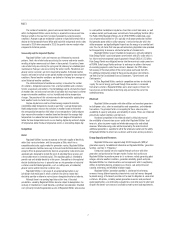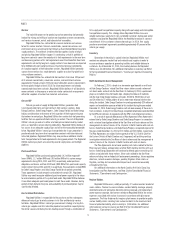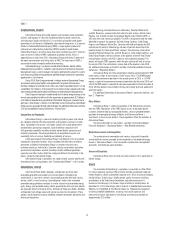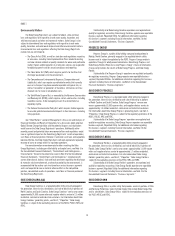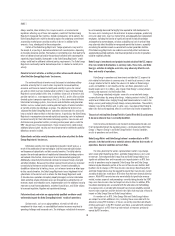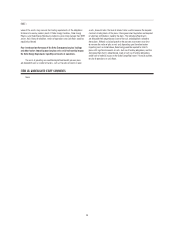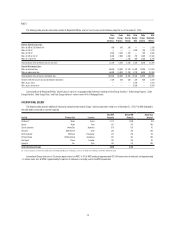Duke Energy 2014 Annual Report Download - page 35
Download and view the complete annual report
Please find page 35 of the 2014 Duke Energy annual report below. You can navigate through the pages in the report by either clicking on the pages listed below, or by using the keyword search tool below to find specific information within the annual report.
PART I
15
Business Segments
Duke Energy Ohio operates two business segments: Regulated Utilities
and Commercial Power. For additional information on each of these business
segments, including fi nancial information, see Note 3 to the Consolidated
Financial Statements, “Business Segments.”
The following is a brief description of the nature of operations of each of
Duke Energy Ohio’s reportable business segments.
REGULATED UTILITIES
Regulated Utilities transmits and distributes electricity in Ohio. Regulated
Utilities also generates, transmits and distributes electricity in Kentucky.
Regulated Utilities also transports and sells natural gas in Ohio and Kentucky.
Duke Energy Ohio applies regulatory accounting to substantially all of the
operations in its Regulated Utilities operating segment.
Duke Energy Ohio’s Regulated Utilities service area covers 3,000 square
miles and supplies electric service to 840,000 residential, commercial and
industrial customers and provides regulated transmission and distribution
services for natural gas to 500,000 customers. See Item 2, “Properties” for
further discussion of Duke Energy Ohio’s Regulated Utilities generating facilities.
See Note 4 to the Consolidated Financial Statements, “Regulatory
Matters,” for further discussion related to regulatory fi lings.
COMMERCIAL POWER
On August 21, 2014, Duke Energy entered into an agreement to sell
Commercial Power’s Midwest generation business to Dynegy. The transaction
is conditioned on approval by FERC, and is expected to close by the end of the
second quarter of 2015. The results of these operations have been reclassifi ed
to Discontinued Operations on the Consolidated Statements of Operations and
Comprehensive Income. For additional information on the Midwest generation
business disposition see Note 2 to the Consolidated Financial Statements,
“Acquisitions, Dispositions and Sales of Other Assets.”
For additional information on Duke Energy Ohio’s Commercial Power
generating facilities, see Item 2, “Properties.”
DUKE ENERGY INDIANA
Duke Energy Indiana is a regulated public utility primarily engaged in
the generation, transmission, distribution and sale of electricity in portions of
Indiana. Duke Energy Indiana’s service area covers 23,000 square miles and
supplies electric service to 810,000 residential, commercial and industrial
customers. See Item 2, “Properties” for further discussion of Duke Energy
Indiana’s generating facilities, transmission and distribution. Duke Energy
Indiana is subject to the regulatory provisions of the IURC and FERC.
Substantially all of Duke Energy Indiana’s operations are regulated and
qualify for regulatory accounting. Duke Energy Indiana operates one reportable
business segment, Regulated Utility. For additional information regarding
this business segment, including fi nancial information, see Note 3 to the
Consolidated Financial Statements, “Business Segments.”
ITEM 1A. RISK FACTORS
In addition to other disclosures within this Form 10-K, including
Management’s Discussion and Analysis – Matters Impacting Future Results
for each registrant in Item 7, and other documents fi led with the SEC from time
to time, the following factors should be considered in evaluating Duke Energy
and its subsidiaries. Such factors could affect actual results of operations and
cause results to differ substantially from those currently expected or sought.
Unless otherwise indicated, risk factors discussed below generally relate to
risks associated with all of the Duke Energy Registrants. Risks identifi ed at the
Subsidiary Registrant level are generally applicable to Duke Energy.
REGULATORY, LEGISLATIVE AND LEGAL RISKS
The Duke Energy Registrants’ regulated electric revenues, earnings and
results are dependent on state legislation and regulation that affect
electric generation, transmission, distribution and related activities, which
may limit their ability to recover costs.
The Duke Energy Registrants’ regulated utility businesses are regulated
on a cost-of-service/rate-of-return basis subject to statutes and regulatory
commission rules and procedures of North Carolina, South Carolina, Florida,
Ohio, Indiana and Kentucky. If the Duke Energy Registrants’ regulated utility
earnings exceed the returns established by the state utility commissions,
retail electric rates may be subject to review and possible reduction by the
commissions, which may decrease the Duke Energy Registrants’ future earnings.
Additionally, if regulatory bodies do not allow recovery of costs incurred in
providing service on a timely basis, the Duke Energy Registrants’ future earnings
could be negatively impacted.
If legislative and regulatory structures were to evolve in such a way that
the Duke Energy Registrants’ exclusive rights to serve their regulated customers
were eroded, their future earnings could be negatively impacted.
Deregulation or restructuring in the electric industry may result in
increased competition and unrecovered costs that could adversely affect
the Duke Energy Registrants’ fi nancial position, results of operations or
cash fl ows and their utility businesses.
Increased competition resulting from deregulation or restructuring
legislation could have a signifi cant adverse impact on the Duke Energy
Registrants’ results of operations, fi nancial position or cash fl ows. Retail
competition and the unbundling of regulated electric service could have a
signifi cant adverse fi nancial impact on the Duke Energy Registrants due to
an impairment of assets, a loss of retail customers, lower profi t margins or
increased costs of capital. The Duke Energy Registrants cannot predict the
extent and timing of entry by additional competitors into the electric markets.
The Duke Energy Registrants cannot predict if or when they will be subject to
changes in legislation or regulation, nor can they predict the impact of these
changes on their fi nancial position, results of operations or cash fl ows.
The Duke Energy Registrants’ businesses are subject to extensive federal
regulation that will affect their operations and costs.
The Duke Energy Registrants are subject to regulation by FERC, NRC,
EPA and various other federal agencies as well as the North American Electric
Reliability Corporation. Regulation affects almost every aspect of the Duke Energy
Registrants’ businesses, including, among other things, their ability to: take
fundamental business management actions; determine the terms and rates of
transmission and distribution services; make acquisitions; issue equity or debt
securities; engage in transactions with other subsidiaries and affi liates; and
pay dividends upstream to the Duke Energy Registrants. Changes to federal
regulations are continuous and ongoing. The Duke Energy Registrants cannot
predict the future course of regulatory changes or the ultimate effect those
changes will have on their businesses. However, changes in regulation can cause
delays in or affect business planning and transactions and can substantially
increase the Duke Energy Registrants’ costs.
The Dan River ash basin release could impact the reputation and fi nancial
condition of the Duke Energy Registrants.
There is uncertainty regarding the extent and timing of future additional
costs and liabilities related to the Dan River ash basin release, including the
amount and extent of any pending or future civil or criminal penalties, and
resulting litigation. These uncertainties are likely to continue for an extended




